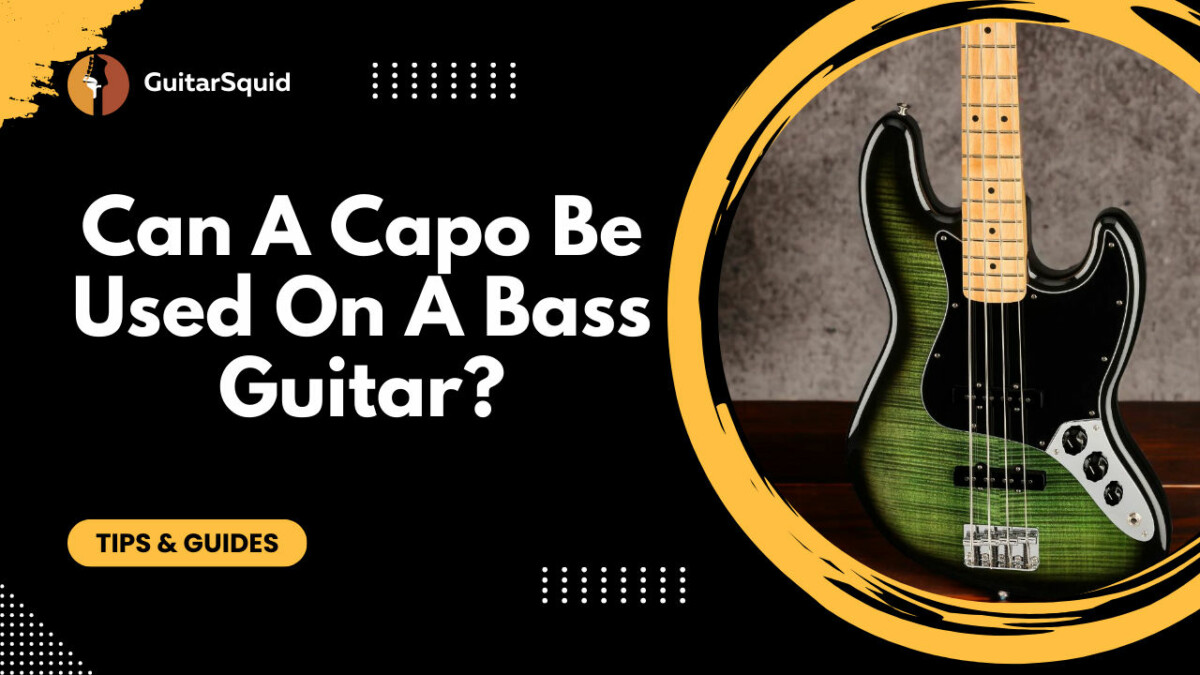Ever jammed on your bass and pondered about incorporating a capo into your music? You’re definitely not the only one. Even though it’s a rarity, there’s a group of bassists out there who absolutely vouch for it.
A capo on a bass guitar, sounds a bit out of the box, right? But hey, let’s not write it off just yet. We’re about to delve into the odd and exciting, exploring what could be, the potential upsides, and heck, even the cons of this approach. For those who are new to the bass guitar or have just picked it up later in life, like many people learning to play bass when you’re 50, a capo can be a great tool to experiment with.
Brace yourself, we’re about to uncover a whole new viewpoint on the use of capos in the bass guitar scene.
Can You Use A Capo With A Bass Guitar?
Yes, you can use a capo on a bass guitar. But, make sure you get a capo that fits the bass’s wider neck and has enough tension to hold down the thicker strings.
So, you’ve got the lowdown on what a capo does, right? And you’re scratching your head, thinking, ‘Why don’t we see these bad boys on bass guitars more often?’ Well, the answer’s a bit of a mixed bag. For some bassists, especially those playing bass guitar when you have acrylic nails, the use of a capo can be an advantage to prevent potential discomfort.
Bass guitars are a different beast – their lower tuning and beefy strings, plus a less frequent need for strumming out chords, mean capos are a bit of a rarity. But hey, that shouldn’t stop you from diving right into the capo pool and seeing what’s what.
You could find that messing around with different capo techniques on your bass guitar opens up a whole new universe of funky sounds. Sure, it’s not the most typical move, but a capo can seriously shake up your bass playing, giving you some fresh and fun sounds.
Whether it’s adapting to tracks where your mate on the six-string is rocking a capo, or you’re just keen to play around with some wild alternate tunings, using a capo on a bass guitar is definitely something worth checking out. It might be off the beaten track, but sometimes that’s where the magic happens, right?
Potential Benefits of Using a Capo on a Bass Guitar
Not many bassists are into using capos, but trust me, it’s a game-changer. Let’s break down four ways a capo can boost your bass game:
- Mix it up with alternative tunings: With a capo, you can play around with different tunings on your bass, adding a fresh twist to your grooves and techniques.
- Unlock new sounds with expanded tonal range: A capo has this cool effect of shortening the string length, which essentially gives your bass a different vibe and sound. It’s like a whole new instrument!
- Say goodbye to finger strain: Complex chord shapes giving you a tough time? Slap on a capo. It simplifies those gnarly chords and saves your fingers from a world of pain, making it easier to jam out to your favorite tracks.
- Unleash your creativity: A capo can push your boundaries and get your creative juices flowing. It’s a ticket to unexplored musical territories.
Challenges and Drawbacks of Capo Usage on Bass Guitars
Playing around with a capo on a bass guitar can be a real brain-teaser, trust me. It’s not like the usual stringed instruments, it’s got its own set of hurdles. The larger strings and that deep, low tuning make the whole capo game more perplexing and less of a go-to for us bassists.
If you’re trying to jam along to a song where the guitarist has slapped on a capo, you might need to switch up your game plan. It’s all about getting your head around a ‘phantom’ capo, essentially tricking your brain into shifting the entire fretboard to match the key change.
Now, if that sounds like a total mind-bender, there’s another way. You could just switch up the key on your bass, without any capo in sight. Just transpose the notes and you’re good to go. But fair warning, it’s going to be a bit of a workout for your hands.
Adding a capo to the mix on a bass can sometimes mean you need to retune or mess with the string tension. But, let’s be real, who’s got time for that? It’s not always the most practical move. So, while capos can be handy, they do come with their fair share of challenges on the bass.
Famous Instances of Capo Use in Bass Guitar History
As you dive deeper into your bass guitar journey, you’ll stumble upon some legendary moments when a capo was rocked on a bass. Not only are these instances super inspiring, but they also serve as the ultimate proof that in music, there’s no such thing as set-in-stone rules.
- Paul McCartney: The guy who gave us the bass lines of The Beatles was no stranger to a capo. He famously slapped one on during the recording of ‘Rubber Soul.’
- Carol Kaye: If you’re into 60s music, you’ve probably heard of Carol Kaye. She was a session player back in the day and wasn’t afraid to whip out a capo to get those unique vibes.
- Sting: The bass backbone of The Police has been known to use a capo from time to time to create some killer compositions.
- Jack Bruce: The bass player from Cream was all about experimenting with different sounds. He’d use a capo with alternate tunings to really push the envelope.
These bass legends who weren’t afraid to mix it up with a capo show there’s more than one way to play the bass. They pushed the limits of what was considered ‘normal’ for bassists, and that’s pretty rad.



